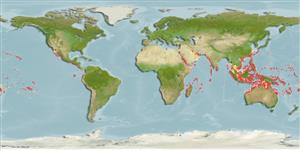Classification / Names
Common names from other countries
Main reference
Size / Weight / Age
Max length : 150 cm TL male/unsexed; (Ref. 1602); common length : 50.0 cm TL male/unsexed; (Ref. 30573)
Environment
Marine; reef-associated; depth range 3 - 50 m (Ref. 30573)
Climate / Range
Tropical, preferred ?; 30°N - 24°S, 32°E - 78°W
Distribution
Indo-Pacific: Red Sea and East Africa (Ref. 33390) and Persian Gulf (Ref. 68964) to the Society Islands, north to the Ryukyu and Hawaiian islands, south to the Great Barrier Reef. Eastern Central Pacific: southern Baja California, Mexico and from Guatemala to northern Colombia, including the Galapagos (Ref. 9324).
Countries | FAO areas | Ecosystems | Occurrences | Introductions
Short description
IUCN Red List Status (Ref. 115185)
Threat to humans
Harmless
Human uses
Fisheries: minor commercial; aquarium: commercial
More information
ReferencesAquacultureAquaculture profileStrainsGeneticsAllele frequenciesHeritabilityDiseasesProcessingMass conversion
Tools
Special reports
Download XML
Internet sources
Estimates of some properties based on models
Phylogenetic diversity index
PD50 = 1.0000 many relatives (e.g. carps) 0.5 - 2.0 few relatives (e.g. lungfishes)
Trophic Level
3.4 ±0.43 se; Based on food items.
Resilience
Very Low, minimum population doubling time more than 14 years (Preliminary K or Fecundity.)
Vulnerability
Very high vulnerability (78 of 100)
Price category
